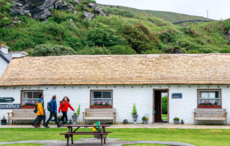The grand old wings of Ireland's National Gallery in Dublin have been restored to their former glory - now's the time to visit.
For years the oldest wings of the National Gallery of Ireland on Merrion Square, Dublin, were a confusing muddle of venerable but slightly tatty galleries. After a massive restoration project, the rooms have been fully restored to their original elegant majesty. The two old diverging wings, built in different time periods, are now airily connected through a once-hidden courtyard.
Read more: Dublin and surrounding areas tours
The Gallery’s collection, which includes works by Caravaggio, Rembrandt, Monet and Vermeer, along with masterpieces by our own Jack Yeats, is surprisingly impressive given the budget available at any one time. Now these paintings – and their admirers – have room to breathe.
The Dargan Wing, which dates from 1864,and the Milltown Wing, which was added in 1901, were in poor repair for several years. Galleries in the Dargan Wing had to close during heavy rain (not unusual in Ireland!) because of the leaking roof. The buildings were a fire hazard, the wiring antiquated and the humidity levels a nightmare for conservationists.
Read More: National Gallery re-opens after extensive six-year renovation
Many of the paintings needed restorative work and one, Argenteuil Basin with a Single Sail Boat by Claude Monet required major repair work having been slashed by a member of the public.
And so the historic wings disappeared from view behind hoardings and work began.
That Ireland even has a National Gallery is thanks to William Dargan, the son a of tenant farmer, who rose to become a master engineer of the Victorian era. Inspired by a visit to the Great Exhibition in London, Dargan decided to bring a similar spectacle to Dublin.
The lawn of Leinster House, the ancestral home of the Duke of Leinster, and then owned by the Royal Dublin Society, provided the stage for a domed glass palace. A third of the space was dedicated to art, on Dargan’s instructions, and proved surprisingly popular. Known as the practical patriot, Dargan spent £20,000 on the entire project but undeterred set up a committee to promote the establishment of a National Gallery of Ireland.
Read more: Kerry and the Wild Atlantic Way tours
And so what is now known as the Dargan Wing opened its doors to the public with 112 pictures on display. Dargan could not attend the opening but today his statue sits outside the Gallery facing across Leinster House to the National History Museum. Leinster House, today, is the seat of the Irish Dáil (parliament) and the surrounding Merrion Square is still among the finest examples of Georgian architecture in Ireland.
Behind the hoarding, the team of architects, engineers and builders were discovering the buried history of the site. Excavations to create a space-age ‘control’ room for the old wings, uncovered a stockpile of seashells, possibly the remnants of a shell-fish stall of old, along with a well.
The concrete vaults were constructed by underpinning, an “unusual and stressful process”, according to the project engineer. These vaults contain all the ducts and machinery to keep the galleries above at exactly the right temperature and humidity. Meanwhile the roofs of the entire building were replaced and original features carefully removed and sent off to be restored.
Read more: Northern Ireland and Game of Thrones tours
Dargan donated £2,000 of his own money to purchase paintings for the new Gallery and through purchases, bequests and donations, the collection began to grow. In 1901, the Countess of Milltown donated more than 200 pictures to the collection and a new wing was needed to house them. The Milltown Wing was built, featuring elaborate oak doorframes to a succession of connected smaller galleries. By 1968, another wing was needed and later named after Sir Alfred and Lady Beit who gifted the gallery 17 old masters from their own collection. Finally today we have the Millenium Wing, a modern structure, which opens around the corner from Merrion Square on Clare Street. In its own way, the entire Gallery represents the progression of Ireland from a Victorian city of the British Empire to the contemporary European capital it is today.
The old Dargan and Milltown Wings reflect the time period in which they were built and rather than merging them together the renovation team found an ingenious way of both separating and bringing them together.
The Shaw Room in the old Dargan Wing was originally used as a sculpture gallery lit from the side by four large windows. As the painting collection expanded the windows were boarded up and used to hang artworks. Behind the windows was a courtyard left when the adjacent Milltown Wing went up. Only a handful of gallery staff knew this spaced even existed. Under the renovation plan, the windows were recovered, opening up the courtyard as a central space between the two wings.
When the Gallery finally reopened to the public earlier this year, the effect was the reverse of a visit to a childhood haunt; instead of everything being smaller and shabbier, the old familiar wings felt larger and grander.
Read more: Galway and the West tours
The Shaw Room is an extravagant confection of cornicing and chandeliers. Gone are the old mustard yellow walls; now it is painted a deep blue on one side and flooded with light from the newly opened courtyard on the other. Staircases sweep elegantly to the Grand Gallery above. The courtyard is covered with a light-refracting roof and a wall of white ceramic tiles. It’s set off by a swirling white structure Magnum Modus, by Joseph Walsh.
Aside from reclaiming a beautiful building, Dubliners also got to view again a host of artworks, which went into storage while the renovation was in progress. Some, such as the spectacular Marriage of Aoife and Strongbow by Daniel Maclise were lovingly restored. This 10 x 17 foot picture depicts the marriage of the Norman invader Richard de Clare (known as Strongbow) to the daughter of the King of Leinster. Painted around the same year the Gallery was founded, its rich colours had faded and much of the meticulous detail was lost. Now the victorious Normans and the vanquished Irish guests have been restored to glorious life, as Aoife bows to her new lord.
The paintings have re-arranged with Irish artworks including pieces by John Lavery and Jack Yeats on the ground floor. Art from other European collections are hung of the upper floor. The pieces are arranged chronologically. There’s a dark room featuring stained glass windows including works by the renowned Harry Clarke. There’s also a portrait gallery featuring well-known Irish people, the rock star Bono and the hurling champion Henry Shefflin, for example.
It was a gigantic task bringing these old wings back to their former glory and simultaneously equipping them with the kind of state-of-the-art equipment that will keep Ireland’s burgeoning collection of art work in pristine condition for generations to come.
Read more: Mayo and the Cliffs of Moher tours




Comments